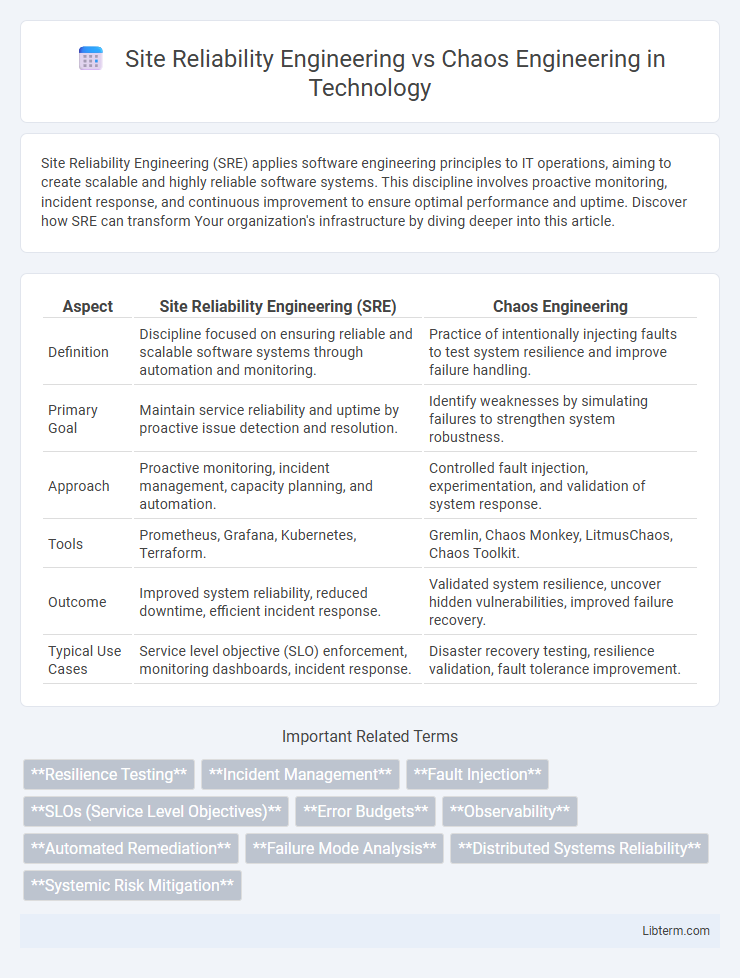Site Reliability Engineering (SRE) applies software engineering principles to IT operations, aiming to create scalable and highly reliable software systems. This discipline involves proactive monitoring, incident response, and continuous improvement to ensure optimal performance and uptime. Discover how SRE can transform Your organization's infrastructure by diving deeper into this article.
Table of Comparison
| Aspect | Site Reliability Engineering (SRE) | Chaos Engineering |
|---|---|---|
| Definition | Discipline focused on ensuring reliable and scalable software systems through automation and monitoring. | Practice of intentionally injecting faults to test system resilience and improve failure handling. |
| Primary Goal | Maintain service reliability and uptime by proactive issue detection and resolution. | Identify weaknesses by simulating failures to strengthen system robustness. |
| Approach | Proactive monitoring, incident management, capacity planning, and automation. | Controlled fault injection, experimentation, and validation of system response. |
| Tools | Prometheus, Grafana, Kubernetes, Terraform. | Gremlin, Chaos Monkey, LitmusChaos, Chaos Toolkit. |
| Outcome | Improved system reliability, reduced downtime, efficient incident response. | Validated system resilience, uncover hidden vulnerabilities, improved failure recovery. |
| Typical Use Cases | Service level objective (SLO) enforcement, monitoring dashboards, incident response. | Disaster recovery testing, resilience validation, fault tolerance improvement. |
Introduction to Site Reliability Engineering
Site Reliability Engineering (SRE) is a discipline that applies software engineering principles to IT operations, aiming to create scalable and highly reliable software systems. It emphasizes automation, monitoring, and continuous improvement to maintain system availability and performance. Unlike Chaos Engineering, which proactively tests system resilience through fault injection, SRE focuses on preventing outages by designing robust infrastructure and enforcing service-level objectives (SLOs).
Understanding Chaos Engineering
Chaos Engineering is a proactive discipline focused on intentionally introducing controlled failures into complex systems to identify vulnerabilities and improve overall resilience. Site Reliability Engineering (SRE) emphasizes maintaining system reliability through automation, monitoring, and incident response, while Chaos Engineering complements SRE by testing real-world failure scenarios before they occur. Understanding Chaos Engineering enhances the ability to anticipate unpredictable issues, optimize system fault tolerance, and minimize downtime in large-scale distributed environments.
Core Principles: SRE vs Chaos Engineering
Site Reliability Engineering (SRE) centers on reliability, automation, and service-level objectives (SLOs) to maintain system stability and performance through proactive monitoring and incident response. Chaos Engineering emphasizes intentional experimentation and fault injection to uncover system vulnerabilities and improve resilience by simulating real-world failures. Both disciplines prioritize system robustness but differ in approach: SRE focuses on preventing outages using data-driven practices, while Chaos Engineering actively challenges system assumptions to strengthen failure tolerance.
Key Objectives and Goals
Site Reliability Engineering (SRE) focuses on maintaining system reliability, availability, and performance through automation, monitoring, and incident response to minimize downtime and ensure seamless user experience. Chaos Engineering aims to proactively identify system weaknesses by intentionally injecting faults and conducting controlled experiments to improve system resilience and failure recovery. Both disciplines share the goal of enhancing system robustness but approach it via preventive reliability measures (SRE) versus fault injection testing and continuous validation of system behavior (Chaos Engineering).
Tools and Technologies Used
Site Reliability Engineering (SRE) leverages tools like Prometheus for monitoring, Grafana for visualization, and Kubernetes for orchestration to ensure system reliability and scalability. Chaos Engineering employs platforms such as Gremlin, Chaos Monkey, and LitmusChaos to introduce controlled failures, enabling teams to validate system resilience and fault tolerance. Both disciplines rely on automation frameworks and cloud-native technologies but differ in their core focus--SRE emphasizes proactive system maintenance, while Chaos Engineering concentrates on experimentation through deliberate disruptions.
Testing Approaches and Practices
Site Reliability Engineering (SRE) emphasizes proactive monitoring, automation, and infrastructure resilience through practices like Service Level Objectives (SLOs) and error budgets to ensure system reliability. Chaos Engineering focuses on deliberately injecting faults and stress tests into production environments to identify weaknesses and improve system robustness under unpredictable conditions. Both approaches prioritize testing but differ in focus: SRE targets maintaining stability and preventing failures, while Chaos Engineering aims to uncover hidden vulnerabilities by simulating real-world disruptions.
Impact on System Reliability
Site Reliability Engineering (SRE) emphasizes proactive monitoring, automation, and incident management to maintain system reliability by preventing failures and ensuring fast recovery. Chaos Engineering complements SRE by intentionally injecting faults and simulating failures to identify weaknesses and improve system resilience under real-world stress conditions. Together, they enhance overall system reliability by combining prevention with rigorous testing of failure responses.
Challenges and Limitations
Site Reliability Engineering (SRE) faces challenges in balancing system reliability with rapid feature deployment and managing complex incident responses. Chaos Engineering encounters limitations related to the unpredictable nature of fault injection, which can lead to unintended system outages if not carefully controlled. Both approaches require robust monitoring and precise tooling to mitigate risks while improving system resilience.
Use Cases and Real-World Examples
Site Reliability Engineering (SRE) primarily focuses on building scalable and reliable systems by implementing automation, monitoring, and incident response strategies, as exemplified by Google's SRE team managing vast infrastructure with Service Level Objectives (SLOs). Chaos Engineering targets proactively identifying system weaknesses through controlled fault injections and experiments, illustrated by Netflix's Simian Army, which continuously tests resilience by simulating failures in production environments. Use cases for SRE revolve around maintaining uptime and performance in cloud platforms and web services, while Chaos Engineering is crucial in validating recovery procedures and improving fault tolerance in microservices architecture.
Choosing the Right Approach for Your Organization
Site Reliability Engineering (SRE) emphasizes maintaining system stability and reliability through proactive monitoring, automation, and incident management, making it ideal for organizations prioritizing consistent uptime and operational efficiency. Chaos Engineering focuses on intentionally injecting failures to test system resilience and uncover weaknesses, best suited for teams aiming to improve fault tolerance and disaster recovery capabilities. Selecting the right approach depends on your organization's maturity level, risk tolerance, and specific reliability goals to balance stability with continuous improvement.
Site Reliability Engineering Infographic

 libterm.com
libterm.com